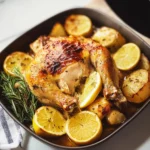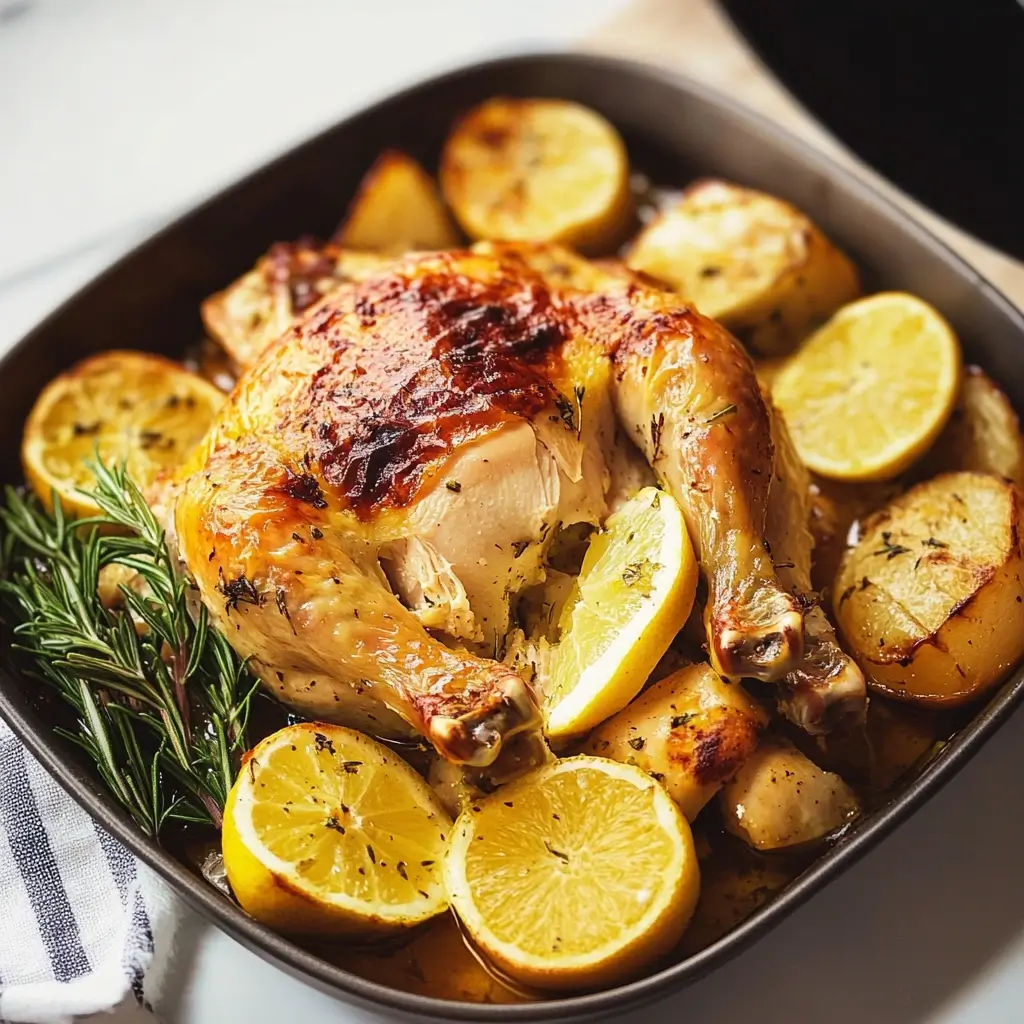There’s nothing quite like the aroma of a roasting chicken filling your kitchen, promising a comforting and delicious meal. For years, I’ve chased the perfect roast chicken – one with deeply flavorful, juicy meat and irresistibly crispy skin, reminiscent of those mouthwatering rotisserie chickens you find at your favorite deli. This Citrus & Herb Roast Chicken recipe has finally cracked the code in my kitchen. From the first bite, my family was hooked. The bright, zesty notes of lemon and orange beautifully complement the savory herbs, creating a symphony of flavors that elevates the humble chicken to gourmet status. What truly sets this recipe apart is its simplicity. The hands-off marinading and roasting process makes it ideal for busy weeknights, yet it’s impressive enough to grace your table for a special occasion. Trust me, this recipe is a game-changer. Prepare to be amazed at how easily you can achieve rotisserie-inspired perfection right in your own oven.
Ingredients: The Foundation of Flavor
This recipe champions fresh, vibrant ingredients that work together to create a truly memorable roast chicken. Let’s delve into each component and understand its crucial role in achieving the perfect citrus and herb infused flavor.
For the Flavorful Brine & Rub:
- 1 tbsp Kosher Salt: Salt is the cornerstone of flavor enhancement. Kosher salt, with its larger crystals, adheres nicely to the chicken and provides a clean, salty taste. It’s crucial for drawing out moisture and allowing the herb and citrus flavors to penetrate deeply into the meat, resulting in a more tender and flavorful chicken. Don’t substitute table salt directly without adjusting the quantity, as it’s denser and saltier.
- 1 tbsp Lemon Zest: The bright, aromatic zest of a lemon is essential for that signature citrusy lift. Make sure to zest only the yellow part of the peel, avoiding the bitter white pith underneath. Fresh lemon zest is key; the bottled lemon flavor simply won’t compare. The zest releases its oils during roasting, infusing the chicken with a vibrant, sunny flavor that cuts through the richness of the poultry.
- 1 tbsp Orange Zest: Adding orange zest introduces a touch of sweetness and a slightly different citrus profile that beautifully complements the lemon. Just like with the lemon, ensure you zest only the orange part of the peel. The combination of lemon and orange zest creates a balanced citrusy depth that is both refreshing and inviting.
- 1 tsp Freshly Ground Black Pepper: Pepper provides a crucial layer of spice and warmth. Freshly ground black pepper is always preferred for its bolder, more complex flavor compared to pre-ground pepper, which can often taste stale. The pepper complements the citrus and herbs, adding a subtle kick that enhances the overall flavor profile.
- ¼ tsp Cayenne Pepper: A pinch of cayenne pepper adds a gentle warmth without making the chicken overly spicy. It provides a subtle background heat that balances the citrus and herbs, adding another dimension of flavor. If you prefer no heat, you can omit it, but it truly adds a nuanced layer to the dish.
- 1 tsp Smoked Paprika: Smoked paprika is the secret ingredient for adding a hint of smoky depth and beautiful color to the chicken skin. Its smoky notes mimic the flavors you might get from a rotisserie, adding complexity and richness. It also contributes to the lovely reddish-brown hue of the roasted chicken.
- 3 cloves Garlic, Pressed or Minced: Garlic is a foundational aromatic that brings savory depth to the rub. Pressed or minced garlic releases its pungent oils, infusing the chicken with its unmistakable flavor. Fresh garlic is a must for this recipe; garlic powder will not provide the same robust flavor.
- 1 tbsp Minced Fresh Thyme: Thyme offers a classic, earthy, and slightly lemony herbaceousness that pairs perfectly with chicken and citrus. Fresh thyme is preferred for its vibrant aroma and flavor. If you must use dried thyme, reduce the quantity to 1 teaspoon as dried herbs are more concentrated.
- 2 tsp Minced Fresh Rosemary: Rosemary provides a piney, slightly pungent, and robust flavor that beautifully complements the thyme and citrus. Fresh rosemary is essential for its aromatic oils and vibrant flavor. If using dried rosemary, reduce the quantity to ¾ teaspoon.
- 3-4 lb Whole Chicken (giblets removed): The star of the show! Opt for a good quality whole chicken, ideally around 3-4 pounds, which is a manageable size for roasting and serving 6 people. Ensure the giblets (neck, gizzard, liver, heart) are removed from the cavity. Patting the chicken dry before applying the rub is crucial for crispy skin.
- 1 tbsp Neutral Oil: A neutral oil like vegetable, canola, or grapeseed oil is used to coat the skillet or sheet pan and to help the chicken skin crisp up beautifully during roasting. Avoid strongly flavored oils like olive oil, which can compete with the citrus and herb flavors.
For the Flavorful Basting Liquid:
- 4 tbsp Unsalted Butter: Butter is the key to rich flavor and golden-brown, crispy skin. Unsalted butter allows you to control the saltiness of the dish, especially since the chicken is already brined. The butter melts and bastes the chicken, creating a luscious, flavorful coating.
- 2 tbsp Fresh Lemon Juice: Fresh lemon juice reinforces the citrusy notes and adds a touch of acidity to balance the richness of the butter. It also helps tenderize the chicken and keeps it moist during roasting. Freshly squeezed lemon juice is far superior in flavor to bottled juice.
- 2 tbsp Fresh Orange Juice: Similar to lemon juice, fresh orange juice adds another layer of citrusy sweetness and acidity to the basting liquid, complementing the zest and enhancing the overall flavor profile. Freshly squeezed orange juice is essential for the best flavor.
- 2 sprigs Fresh Thyme: Adding fresh thyme sprigs to the basting liquid further intensifies the thyme flavor and infuses the butter with its aromatic oils. The sprigs release their flavor slowly as the butter simmers.
- 1 sprig Fresh Rosemary: Just like the thyme, fresh rosemary sprigs in the basting liquid enhance the rosemary flavor and add a fragrant, piney note to the butter. The sprigs infuse the butter as it simmers, creating a deeply flavorful basting liquid.
Instructions: Step-by-Step to Roast Chicken Perfection
Follow these detailed instructions to create a Citrus & Herb Roast Chicken that rivals any rotisserie version. Each step is designed to maximize flavor and ensure perfectly cooked, crispy-skinned chicken.
Step 1: Crafting the Aromatic Herb & Citrus Rub
- In a medium-sized bowl, embark on creating your flavor base. Combine the 1 tbsp kosher salt, 1 tbsp lemon zest, 1 tbsp orange zest, 1 tsp freshly ground black pepper, ¼ tsp cayenne pepper, 1 tsp smoked paprika, 3 cloves pressed or minced garlic, 1 tbsp minced fresh thyme, and 2 tsp minced fresh rosemary.
- Using your fingers, work the mixture together diligently. Massage and rub the ingredients together until they are thoroughly combined and the salt begins to feel slightly moistened by the citrus zest and herb oils. This process helps release the aromas and meld the flavors of the rub, creating a potent flavor bomb for your chicken.
Step 2: Preparing the Chicken – Spatchcocking for Even Cooking and Crispy Skin
- Spatchcocking the Chicken: This technique, also known as butterflying, is a game-changer for roast chicken. It involves removing the backbone, which allows the chicken to lay flat and cook more evenly and quickly, resulting in crispier skin all over.
- Position the chicken breast-side down on a cutting board. Using heavy-duty kitchen shears or a sharp chef’s knife, locate the backbone. It runs along the center of the chicken’s back.
- Cut along one side of the backbone from the tail to the neck. Repeat on the other side of the backbone to completely remove it. You can save the backbone for making chicken stock later.
- Open the chicken up and flip it over so it’s breast-side up. Press firmly down on the breastbone to flatten the chicken. You should hear a slight crack as it flattens. This ensures even cooking.
- Separating the Skin for Maximum Flavor Infusion: This crucial step allows the flavorful rub to penetrate the meat directly, not just sit on the skin. It also facilitates crispier skin as the fat renders out more effectively.
- Gently and carefully lift the skin from the meat of the chicken, starting from the neck cavity and working your way down. Use your fingers to separate the skin from the breast, thighs, and legs. Take your time and be patient to avoid tearing the skin. It’s okay if you can’t separate the skin completely in some areas; the goal is to create pockets for the rub.
Step 3: Marinating for Deep Flavor Penetration
- Applying the Flavor Rub: Now it’s time to generously apply the aromatic rub you prepared.
- Using your hands, work the salt rub under the skin of the chicken, ensuring it comes into direct contact with the meat. Focus on the breast, thighs, and legs, pushing the rub into the pockets you created by separating the skin.
- Next, rub the remaining salt mixture all over the top of the skin of the chicken, ensuring every part is coated.
- Finally, flip the chicken over and rub the underside with any remaining rub.
- Refrigerating for Brining: Cover the chicken tightly with plastic wrap. Refrigerate the chicken for a minimum of 30 minutes and up to 4 hours. This brining time allows the salt to penetrate the meat, enhancing its flavor and moisture retention. Longer brining times (up to 4 hours) will result in even more flavorful and tender chicken. If you are short on time, even 30 minutes of brining will make a difference.
Step 4: Roasting to Golden Brown Perfection
- Preheating the Oven: Preheat your oven to 400°F (200°C). This high temperature is ideal for achieving crispy skin and roasting the chicken through without drying it out.
- Preparing for Roasting:
- Drizzle 1 tbsp neutral oil into a 12-inch cast iron skillet or a sheet pan. The cast iron skillet helps with heat retention and even cooking, but a sheet pan works well too.
- Place the marinated chicken skin-side down in the oiled skillet or sheet pan. This initial skin-down position helps render out the fat and promotes crispier skin on the breast.
- After a minute or two, flip the chicken over so it is skin-side up.
- Tucking the Wings: Tuck the tips of the chicken wings underneath the body of the chicken. This prevents the wing tips from burning during roasting, as they are thin and cook faster.
- Roasting and Basting:
- Place the skillet or sheet pan with the chicken in the preheated oven.
- Preparing the Basting Liquid: While the chicken is roasting, prepare the basting liquid. In a small saucepan, combine the 4 tbsp unsalted butter, 2 tbsp fresh lemon juice, 2 tbsp fresh orange juice, 2 sprigs fresh thyme, and 1 sprig fresh rosemary.
- Bring the mixture to a gentle simmer over medium-low heat. Once the butter is melted and the mixture is simmering, turn the heat to low to keep it warm.
- Basting Regularly: Every 10 minutes, remove the chicken from the oven and generously baste it with the warm butter mixture using a pastry brush or spoon. Be sure to baste all over the skin, allowing the flavorful liquid to coat the chicken. Return the chicken to the oven after each basting. Regular basting is crucial for keeping the chicken moist and developing that beautiful golden-brown, crispy skin.
- Checking for Doneness: Roast the chicken for approximately 1 hour, or until it is beautifully browned and cooked through. The most reliable way to check for doneness is to use a meat thermometer. Insert the thermometer into the thickest part of the thigh, avoiding the bone. The internal temperature should read 160°F (71°C). The juices should run clear when you pierce the thigh with a fork or knife.
Step 5: Resting – The Key to Juicy Chicken
- Once roasted and the internal temperature is reached, remove the chicken from the oven.
- Allow the chicken to rest for 15 minutes before carving. Resting is absolutely crucial! During resting, the juices redistribute throughout the meat, resulting in a much more tender and juicy chicken. If you cut into it immediately, the juices will run out, leaving you with drier meat. Tent the chicken loosely with foil while it rests to keep it warm.
Step 6: Carving and Serving
- After resting, carve the chicken into pieces. Separate the thighs, legs, wings, and breast.
- Serve immediately and enjoy your perfectly roasted Citrus & Herb Chicken!
Nutrition Facts (Estimated)
- Servings: 6 servings
- Calories per Serving (estimated): Approximately 450-550 calories (This is an estimate and can vary based on the size of the chicken, fat content, and serving size).
Note: These are estimated nutritional values. Actual values may vary depending on the specific ingredients used and portion sizes. For more precise nutritional information, you can use a nutrition calculator app or website and input the specific ingredients and quantities used in this recipe.
Preparation Time Breakdown
- Prep Time: 15 minutes (for preparing the rub, spatchcocking the chicken, and applying the rub)
- Brine Time: 30 minutes – 4 hours (refrigeration time for marinating)
- Cook Time: 1 hour (roasting time)
- Rest Time: 15 minutes
- Total Time: Approximately 1 hour 45 minutes to 2 hours 15 minutes (depending on brine time)
How to Serve Your Citrus & Herb Roast Chicken
This versatile roast chicken is delicious on its own, but it truly shines when paired with complementary side dishes. Here are some serving suggestions to create a complete and satisfying meal:
- Classic Sides:
- Roasted Vegetables: Roast vegetables like potatoes, carrots, broccoli, Brussels sprouts, or asparagus alongside the chicken in the oven. Toss them with olive oil, salt, pepper, and herbs like rosemary or thyme for a flavorful and healthy side.
- Mashed Potatoes: Creamy mashed potatoes are a comforting and classic pairing for roast chicken. Elevate them by adding roasted garlic, herbs, or a swirl of butter.
- Rice Pilaf or Quinoa: A fluffy rice pilaf or quinoa provides a light and flavorful grain side dish. Consider adding herbs, nuts, or dried fruits to enhance the flavor.
- Green Salad: A fresh green salad with a light vinaigrette provides a refreshing counterpoint to the richness of the chicken. Add seasonal vegetables, fruits, or cheese for extra interest.
- Citrus-Forward Sides:
- Citrus Salad: Highlight the citrus flavors of the chicken with a vibrant citrus salad featuring oranges, grapefruits, and lemons. Add segments of avocado, red onion, and a honey-lime dressing for a refreshing and zesty side.
- Lemon Roasted Potatoes: Roast potatoes with lemon wedges, garlic, and herbs for a citrusy and flavorful side that complements the chicken perfectly.
- Orange Glazed Carrots: Glaze carrots with orange juice, butter, and a touch of honey for a sweet and savory side that echoes the citrus notes in the chicken.
- Herby & Aromatic Sides:
- Herb Roasted Potatoes: Roast potatoes with a generous amount of fresh herbs like rosemary, thyme, and parsley for an aromatic and flavorful side.
- Garlic Bread: Crusty garlic bread is always a welcome addition to any roast chicken meal.
- Stuffing or Dressing: A classic bread stuffing or cornbread dressing, flavored with herbs and vegetables, is a hearty and comforting side dish.
- Sauces & Gravies:
- Pan Gravy: Make a delicious pan gravy using the chicken drippings from the roasting pan. Skim off excess fat, then whisk in flour to create a roux, and gradually add chicken broth or stock. Season with salt, pepper, and herbs.
- Citrus Pan Sauce: Create a light and bright citrus pan sauce by deglazing the roasting pan with white wine or chicken broth. Add a squeeze of lemon and orange juice, a knob of butter, and fresh herbs.
- Chimichurri Sauce: A vibrant and herbaceous chimichurri sauce, made with parsley, cilantro, garlic, olive oil, and vinegar, provides a zesty and fresh contrast to the richness of the chicken.
Additional Tips for Roast Chicken Success
- Start with a High-Quality Chicken: The quality of your chicken will significantly impact the final flavor. Opt for a pasture-raised or organic chicken if possible, as they often have better flavor and texture.
- Pat the Chicken Dry: Before applying the rub, thoroughly pat the chicken dry with paper towels. This removes excess moisture and helps the skin crisp up beautifully during roasting.
- Don’t Skip the Brine (Even a Short One Helps): While the recipe calls for a “dry brine” with the salt rub, even a short 30-minute brine makes a noticeable difference in the chicken’s juiciness and flavor. If you have more time, brining for up to 4 hours will further enhance the results.
- Use a Meat Thermometer: A meat thermometer is your best friend when roasting chicken. It ensures that the chicken is cooked to a safe internal temperature (160°F in the thigh) without overcooking and drying it out.
- Let it Rest, Rest, Rest!: Resist the urge to carve the chicken immediately after taking it out of the oven. Resting for 15 minutes allows the juices to redistribute, resulting in a much juicier and more flavorful chicken. Tent it loosely with foil to keep it warm during resting.
Frequently Asked Questions (FAQ)
Q1: Can I use frozen chicken for this recipe?
A: It is best to use a fully thawed chicken for roasting. Roasting a frozen chicken directly will result in uneven cooking, and the outside may become dry and overcooked before the inside is cooked through. Thaw your chicken completely in the refrigerator before starting the recipe.
Q2: Can I skip spatchcocking the chicken?
A: While you can roast the chicken whole without spatchcocking, it is highly recommended to spatchcock it for this recipe. Spatchcocking allows the chicken to cook more evenly and quickly, resulting in crispier skin all over and preventing the breast from drying out before the thighs and legs are cooked through.
Q3: Can I use dried herbs instead of fresh herbs?
A: Fresh herbs are preferred for their vibrant flavor and aroma, but you can substitute dried herbs if necessary. When substituting dried herbs for fresh, use about one-third of the amount called for in the recipe, as dried herbs are more concentrated in flavor. For example, if the recipe calls for 1 tablespoon of fresh thyme, use 1 teaspoon of dried thyme.
Q4: How do I know when the chicken is cooked through?
A: The most reliable way to determine if the chicken is cooked through is to use a meat thermometer. Insert the thermometer into the thickest part of the thigh, avoiding the bone. The internal temperature should read 160°F (71°C). The juices should also run clear when you pierce the thigh with a fork or knife.
Q5: What can I do with leftover roast chicken?
A: Leftover roast chicken is incredibly versatile! You can use it in:
- Chicken Salad: Shredded chicken makes a delicious chicken salad for sandwiches or wraps.
- Chicken Soup: Use the leftover chicken carcass and meat to make a flavorful chicken soup.
- Chicken Tacos or Quesadillas: Shredded chicken is perfect for tacos, quesadillas, or enchiladas.
- Chicken Pot Pie: Use leftover chicken in a comforting chicken pot pie.
- Chicken Stir-fries or Salads: Add shredded or sliced chicken to stir-fries or salads for extra protein.
Enjoy making this Citrus & Herb Roast Chicken – it’s sure to become a family favorite!
Print
Citrus & Herb Roast Chicken Recipe
Ingredients
For the Flavorful Brine & Rub:
- 1 tbsp Kosher Salt: Salt is the cornerstone of flavor enhancement. Kosher salt, with its larger crystals, adheres nicely to the chicken and provides a clean, salty taste. It’s crucial for drawing out moisture and allowing the herb and citrus flavors to penetrate deeply into the meat, resulting in a more tender and flavorful chicken. Don’t substitute table salt directly without adjusting the quantity, as it’s denser and saltier.
- 1 tbsp Lemon Zest: The bright, aromatic zest of a lemon is essential for that signature citrusy lift. Make sure to zest only the yellow part of the peel, avoiding the bitter white pith underneath. Fresh lemon zest is key; the bottled lemon flavor simply won’t compare. The zest releases its oils during roasting, infusing the chicken with a vibrant, sunny flavor that cuts through the richness of the poultry.
- 1 tbsp Orange Zest: Adding orange zest introduces a touch of sweetness and a slightly different citrus profile that beautifully complements the lemon. Just like with the lemon, ensure you zest only the orange part of the peel. The combination of lemon and orange zest creates a balanced citrusy depth that is both refreshing and inviting.
- 1 tsp Freshly Ground Black Pepper: Pepper provides a crucial layer of spice and warmth. Freshly ground black pepper is always preferred for its bolder, more complex flavor compared to pre-ground pepper, which can often taste stale. The pepper complements the citrus and herbs, adding a subtle kick that enhances the overall flavor profile.
- ¼ tsp Cayenne Pepper: A pinch of cayenne pepper adds a gentle warmth without making the chicken overly spicy. It provides a subtle background heat that balances the citrus and herbs, adding another dimension of flavor. If you prefer no heat, you can omit it, but it truly adds a nuanced layer to the dish.
- 1 tsp Smoked Paprika: Smoked paprika is the secret ingredient for adding a hint of smoky depth and beautiful color to the chicken skin. Its smoky notes mimic the flavors you might get from a rotisserie, adding complexity and richness. It also contributes to the lovely reddish-brown hue of the roasted chicken.
- 3 cloves Garlic, Pressed or Minced: Garlic is a foundational aromatic that brings savory depth to the rub. Pressed or minced garlic releases its pungent oils, infusing the chicken with its unmistakable flavor. Fresh garlic is a must for this recipe; garlic powder will not provide the same robust flavor.
- 1 tbsp Minced Fresh Thyme: Thyme offers a classic, earthy, and slightly lemony herbaceousness that pairs perfectly with chicken and citrus. Fresh thyme is preferred for its vibrant aroma and flavor. If you must use dried thyme, reduce the quantity to 1 teaspoon as dried herbs are more concentrated.
- 2 tsp Minced Fresh Rosemary: Rosemary provides a piney, slightly pungent, and robust flavor that beautifully complements the thyme and citrus. Fresh rosemary is essential for its aromatic oils and vibrant flavor. If using dried rosemary, reduce the quantity to ¾ teaspoon.
- 3–4 lb Whole Chicken (giblets removed): The star of the show! Opt for a good quality whole chicken, ideally around 3–4 pounds, which is a manageable size for roasting and serving 6 people. Ensure the giblets (neck, gizzard, liver, heart) are removed from the cavity. Patting the chicken dry before applying the rub is crucial for crispy skin.
- 1 tbsp Neutral Oil: A neutral oil like vegetable, canola, or grapeseed oil is used to coat the skillet or sheet pan and to help the chicken skin crisp up beautifully during roasting. Avoid strongly flavored oils like olive oil, which can compete with the citrus and herb flavors.
For the Flavorful Basting Liquid:
- 4 tbsp Unsalted Butter: Butter is the key to rich flavor and golden-brown, crispy skin. Unsalted butter allows you to control the saltiness of the dish, especially since the chicken is already brined. The butter melts and bastes the chicken, creating a luscious, flavorful coating.
- 2 tbsp Fresh Lemon Juice: Fresh lemon juice reinforces the citrusy notes and adds a touch of acidity to balance the richness of the butter. It also helps tenderize the chicken and keeps it moist during roasting. Freshly squeezed lemon juice is far superior in flavor to bottled juice.
- 2 tbsp Fresh Orange Juice: Similar to lemon juice, fresh orange juice adds another layer of citrusy sweetness and acidity to the basting liquid, complementing the zest and enhancing the overall flavor profile. Freshly squeezed orange juice is essential for the best flavor.
- 2 sprigs Fresh Thyme: Adding fresh thyme sprigs to the basting liquid further intensifies the thyme flavor and infuses the butter with its aromatic oils. The sprigs release their flavor slowly as the butter simmers.
- 1 sprig Fresh Rosemary: Just like the thyme, fresh rosemary sprigs in the basting liquid enhance the rosemary flavor and add a fragrant, piney note to the butter. The sprigs infuse the butter as it simmers, creating a deeply flavorful basting liquid.
Instructions
Step 1: Crafting the Aromatic Herb & Citrus Rub
- In a medium-sized bowl, embark on creating your flavor base. Combine the 1 tbsp kosher salt, 1 tbsp lemon zest, 1 tbsp orange zest, 1 tsp freshly ground black pepper, ¼ tsp cayenne pepper, 1 tsp smoked paprika, 3 cloves pressed or minced garlic, 1 tbsp minced fresh thyme, and 2 tsp minced fresh rosemary.
- Using your fingers, work the mixture together diligently. Massage and rub the ingredients together until they are thoroughly combined and the salt begins to feel slightly moistened by the citrus zest and herb oils. This process helps release the aromas and meld the flavors of the rub, creating a potent flavor bomb for your chicken.
Step 2: Preparing the Chicken – Spatchcocking for Even Cooking and Crispy Skin
- Spatchcocking the Chicken: This technique, also known as butterflying, is a game-changer for roast chicken. It involves removing the backbone, which allows the chicken to lay flat and cook more evenly and quickly, resulting in crispier skin all over.
- Position the chicken breast-side down on a cutting board. Using heavy-duty kitchen shears or a sharp chef’s knife, locate the backbone. It runs along the center of the chicken’s back.
- Cut along one side of the backbone from the tail to the neck. Repeat on the other side of the backbone to completely remove it. You can save the backbone for making chicken stock later.
- Open the chicken up and flip it over so it’s breast-side up. Press firmly down on the breastbone to flatten the chicken. You should hear a slight crack as it flattens. This ensures even cooking.
- Separating the Skin for Maximum Flavor Infusion: This crucial step allows the flavorful rub to penetrate the meat directly, not just sit on the skin. It also facilitates crispier skin as the fat renders out more effectively.
- Gently and carefully lift the skin from the meat of the chicken, starting from the neck cavity and working your way down. Use your fingers to separate the skin from the breast, thighs, and legs. Take your time and be patient to avoid tearing the skin. It’s okay if you can’t separate the skin completely in some areas; the goal is to create pockets for the rub.
Step 3: Marinating for Deep Flavor Penetration
- Applying the Flavor Rub: Now it’s time to generously apply the aromatic rub you prepared.
- Using your hands, work the salt rub under the skin of the chicken, ensuring it comes into direct contact with the meat. Focus on the breast, thighs, and legs, pushing the rub into the pockets you created by separating the skin.
- Next, rub the remaining salt mixture all over the top of the skin of the chicken, ensuring every part is coated.
- Finally, flip the chicken over and rub the underside with any remaining rub.
- Refrigerating for Brining: Cover the chicken tightly with plastic wrap. Refrigerate the chicken for a minimum of 30 minutes and up to 4 hours. This brining time allows the salt to penetrate the meat, enhancing its flavor and moisture retention. Longer brining times (up to 4 hours) will result in even more flavorful and tender chicken. If you are short on time, even 30 minutes of brining will make a difference.
Step 4: Roasting to Golden Brown Perfection
- Preheating the Oven: Preheat your oven to 400°F (200°C). This high temperature is ideal for achieving crispy skin and roasting the chicken through without drying it out.
- Preparing for Roasting:
- Drizzle 1 tbsp neutral oil into a 12-inch cast iron skillet or a sheet pan. The cast iron skillet helps with heat retention and even cooking, but a sheet pan works well too.
- Place the marinated chicken skin-side down in the oiled skillet or sheet pan. This initial skin-down position helps render out the fat and promotes crispier skin on the breast.
- After a minute or two, flip the chicken over so it is skin-side up.
- Tucking the Wings: Tuck the tips of the chicken wings underneath the body of the chicken. This prevents the wing tips from burning during roasting, as they are thin and cook faster.
- Roasting and Basting:
- Place the skillet or sheet pan with the chicken in the preheated oven.
- Preparing the Basting Liquid: While the chicken is roasting, prepare the basting liquid. In a small saucepan, combine the 4 tbsp unsalted butter, 2 tbsp fresh lemon juice, 2 tbsp fresh orange juice, 2 sprigs fresh thyme, and 1 sprig fresh rosemary.
- Bring the mixture to a gentle simmer over medium-low heat. Once the butter is melted and the mixture is simmering, turn the heat to low to keep it warm.
- Basting Regularly: Every 10 minutes, remove the chicken from the oven and generously baste it with the warm butter mixture using a pastry brush or spoon. Be sure to baste all over the skin, allowing the flavorful liquid to coat the chicken. Return the chicken to the oven after each basting. Regular basting is crucial for keeping the chicken moist and developing that beautiful golden-brown, crispy skin.
- Checking for Doneness: Roast the chicken for approximately 1 hour, or until it is beautifully browned and cooked through. The most reliable way to check for doneness is to use a meat thermometer. Insert the thermometer into the thickest part of the thigh, avoiding the bone. The internal temperature should read 160°F (71°C). The juices should run clear when you pierce the thigh with a fork or knife.
Step 5: Resting – The Key to Juicy Chicken
- Once roasted and the internal temperature is reached, remove the chicken from the oven.
- Allow the chicken to rest for 15 minutes before carving. Resting is absolutely crucial! During resting, the juices redistribute throughout the meat, resulting in a much more tender and juicy chicken. If you cut into it immediately, the juices will run out, leaving you with drier meat. Tent the chicken loosely with foil while it rests to keep it warm.
Step 6: Carving and Serving
- After resting, carve the chicken into pieces. Separate the thighs, legs, wings, and breast.
- Serve immediately and enjoy your perfectly roasted Citrus & Herb Chicken!
Nutrition
- Serving Size: one normal portion
- Calories: 450-550





